| Sponsored by:
OCEANS ENTERPRISES Publishers & Distributors |
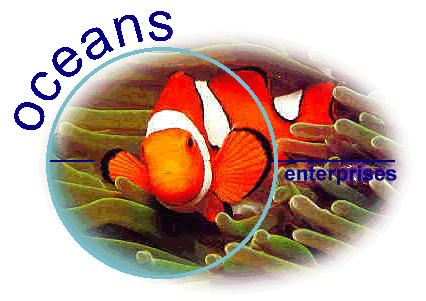 |
|
CLASSIC DIVE BOOKS - Author Lt. Harry E. Rieseberg |
||||||||||||||||||||||||||||||
| Since writing the reviews
below in September 2000, I have had the pleasure of corresponding with
the son, and grandson, of Harry Rieseberg. Grandson Loren Rieseberg contacted
me in November 2001 by email as a result of finding this site. What a delightful
surprise that was. Since then Bob Rieseberg, Harry's son from his first
marriage has been in contact and has provided interesting and valuable
information.
Loren writes: "I found your website on Harry Rieseberg to be rather interesting. He is my grandfather. Your interpretation of his books are largely correct I think. He was one of the earliest "modern" treasure hunters and he did find some interesting wrecks. On the other hand, I think he did embellish his adventures a bit to make the books more interesting." Bob added that he (Harry) wrote thirteen books, and was the writer and technical director for the movie "City Beneath The Sea". He died in l973. He was a co-owner of a diving school for many years, which folded in the 60-70s. And in 2003, I've also had the pleasure of correspondence with Tom Potts in the USA who is, lets get this straight - "my wife's grandmother was Harry's second wife, while Robert Rieseberg's mother was Harry's first wife." Harry had three wives. I managed to find one of Harry's books for Tom's children - thats Harry's great grand children. It gives me a great deal of pleasure to know that the descendants of Harry Rieseberg are taking an interest in his romantic life - or rather romanticised life. As I mention in the review below, Harry Rieseberg gave a great deal of pleasure to many people through his adventures and writing. See below for more of the family. And also see www.harryrieseberg.com
REVIEW by Peter Stone When literally shacked-up with Bob Marx on Beacon Island in 1977, he made mention of one Lieutenant Harry Rieseberg. I can't recall his exact words, but the summary would be, "he's full of ..it". We were in the Abrolhos Islands, diving the historic Dutch East Indiaman Batavia at the time. "He used to see a skeleton lashed to the wheel of every shipwreck", Bob commented. Bob wouldn't fib would he? But I was anxious to get hold of a copy of one of Hero Harry's books, and finally, after many years, managed to find My Compass Points to Treasure. Wow, he certainly looks like a villain on the dust jacket rear where it is stated he is "recognised as the world's foremost authority on the romantic subject of sunken treasure". My copy of Rieseberg's book is the ‘First printed in this edition 1957' which suggests that it was released earlier. It appears to be his fourth book. There are no dates mentioned in the book, so it is difficult to determine when it was that Harry descended into the Caribbean Sea in standard dress, his ‘boys' pumping away on the deck of his schooner Cholita. It tells of the time he once had an office job and "found myself in a nightmare rushing headlong down a concrete canyon, watching over my shoulder as a long-legged desk leaps after me in hot pursuit". So he became a deep-sea diver. You might like to give up at this point, but don't - it gets better. My Compass
Points to Treasure tells of his departure from the concrete canyons
of Washington and down to Jamaica where he finds Port Royal, a ‘Pirate's
Babylon'. Then its back on land to search for pirates plunder, before finding
the wreck of the San Pedro - we are to assume she is Spanish, with
bullion on board. He finds her on the first dive, but gives Lady Luck her
due credit. Twenty thousand dollars richer, he is off to find another wreck,
the San Pedro de Alcantara - no relative to the first San Pedro.
He doesn't find the mother lode of five million, but settles for a haul
of Spanish pieces of eight worth $30,000. But its not all plain sailing.
There are the sharks and the giant spiders and the squid and the giant
crabs - and the horrible octopus to overcome. "Watching every move, I was
revolted and fascinated. I had met this loathsome creature before and paid
dearly for the unsought acquaintance. Presently the thing released itself,
drew together its reaching coils, and darted to a more distant rock, where
it settled down to watch me from its hooded yellow eyes."
Is this a boys-own
yarn, or is Lieutenant Harry Rieseberg fair-dinkum? There is nothing to
show on the book that it is meant to be anything other than a factual story,
although the advert on the back inside fly for ‘Jennings Goes to School'
and other British boy's books is a bit of a giveaway. If Harry didn't take
himself so seriously, this would be fine fiction. I will certainly give
it to young son Sam in a few years to read. "His successes and failures,
his hopes, his fears, his moments of triumph and moments of despair are
here for us to share in a thrilling story of true adventure". Maybe I shouldn't
be so cynical. Maybe I am doing Harry an injustice. Maybe I shouldn't be
influenced by the less than complimentary remarks by the self-acclaimed
maritime archaeologist (and treasure hunter) Bob Marx. Let's just say,
it is a great yarn, Harry.
You are right though, his stories are a great yarn and as a boy I enjoyed reading his book. It did stir the imagination to think of fighting off a gigantic octopus and finding treasure on sunken ships." ... Bill B. ---- Not long after I
found a copy of My Compass Points to Treasure, I managed to locate
a first edition of I Dive For Treasure, by Rieseberg,
published in 1942. This appears to be his second book (after Treasure
of the Buccaneer Sea), and is certainly written as an adult adventure
(read factual) book. It even has a dozen or so mono plates - mainly of
a giant octopus that the fought and slew. A brief glance through the book
establishes the fact that Rieseberg is a genuine ‘deep sea diver' and ‘treasure
hunter'. He is shown squeezing into a steel sphere about four feet in diameter,
which he calls a ‘robot', and descending to a quarter of a mile - 880 feet.
The robot was tethered to a mother ship and lowered straight down - it
appears to have no mobility other than vertical and slight horizontal determined
by the ship's boom from which it hung, and controlled by the mother ship
on instructions from the operator. Two steel claws on arms extend for some
six feet, manipulated by the diver inside. This is a pretty good effort
for the time, and took courage to enter and descend. ‘From the bottom of
the sea the diver could talk with his colleagues on deck - and hear their
shouts as they opened the treasure chests he tied to the end off their
line. The fingers of the long, powerful arms of the robot are so delicate
that Lieut. Rieseberg can pick up a single coin from the deck of a sunken
galleon, or shear off the tentacles of an octopus, which is attacking the
observation ball in which ids the author's companion". And he does indeed
raise a treasure chest full of coins - there is a photograph of it in at
least two of his books.
But back to the book, I Dive For Treasure. This is another ‘adventure story' written in the first person, and in part with dialogue. "My wrecks have to have one quality. Did she have any treasure aboard, Doctor?" There is a hint that the action takes place in 1929, and that Rieseberg was born in 1891 or 1892. His interest in adventure came with Stevenson's Treasure Island. He befriended Teddy Roosevelt Jnr in school and met the President at the White House. The autobiography, initially as a naturalist, doesn't last long but sets the personal background to the book, until he meets Greek George who changed his life.. The early chapters tell in part a potted history of the Spanish fleet, and of observations from diving bells, describing William Beebe's efforts, and lamenting the fact that standard dress is limited - the record depth at the time was 306 feet. Encouraged by his research that showed some 3 billion dollars left on the ocean floor, Harry sets off and by chapter five, he encounters his first battle with a giant octopus, and speaks of his double-action Fairbanks-Morse air pump with 250 of armoured hose that supplied oxygen from above. Oxygen? I this a lapse into fairyland, author's license, or a publisher's intrusion? Unfortunately, Rieseberg doe not take the opportunity of ensuring his books remain on the classic list because he fails to describe the early diving equipment he is using. What sort of helmet does he use? "A new brass helmet - with a light on top". Thanks a lot, Harry. The octopus battles seem to take precedence - a huge monster, one hundred and twenty feet down, with "eager tentacles, their suction cups curved for action". Harry has mixed success in his ventures. He recovers $60,000 in pieces-of-eight from the Santa Paula, and $40,000 from the Santa Cruz, but never seems to find the mother-lode. And after descending a quarter mile down in the robot, slips and breaks his leg on deck, hospitalising him for many weeks. This is not what good fiction is made of. If this were a boys own yarn, Harry would have found the treasure in the octopus' lair and wouldn't have been laid on his back because he fell down his own ship's companionway. I'm beginning to like the guy. He may have an excess of imagination, but he certainly was an adventurer. Chapter twenty-four gives an another indication of the time frame. War has just broken out in Europe - 1938. As an interesting adjunct to the book, Rieseberg includes six pages listing 463 treasure ships that he has researched and identified. He closes with a dream. "The Santissima Conception, the Santa Paula, Vigo Bay, the Merida, the plate flota of Silver Shoals! They are all lying on the bottom, heavy with treasure, their chests bulging with the gold and silver and gems of the century". At least Rieseberg makes no pretensions of being an archaeologist - he is in it for the gold. Adventures in Underwater Treasure Hunting is, it appears, Harry Rieseberg's last book. Published in 1965, it is "more than an exciting adventure story - it is the author's true account of just a few of the highlights of his search for undersea treasure in the Neptunian nightmare of death which waits so impatiently in the sea's bottom. This book is your ticket to terror and mystery in a foreboding Disneyland of the deep. Here are the fantastic adventures of deep-sea daredevil, Lieutenant Harry E. Rieseberg." Not even Harry could write this drivel. Enter the editors of publisher Frederick Fell, Inc, New York. By now Harry is at least seventy-two years of age and probably not too concerned about money or the future of treasure hunting. Only the publisher sees treasure, in a rehash of the same old stories - the pirate city beneath the sea, the Santa Cruz, the battle with octopi. He does find the Santissima Conception after the war, and mentions the new scuba diving equipment, although he does not appear to have used it, for this is a book of regurgitated memories, more for the cause of the publisher the author. It does have a few more photographs showing Harry at work topside and down below, and at the end closes with an "authentic historical treasure map, prepared by Lt. Harry E. Rieseberg, the world's foremost authority on sunken treasure". I have no idea when Harry died, but he would have been satisfied with his life away from concrete canyons and phantom desks. If his books stretched the imagination a little, so be it. Was he a fraud? No, I don't think so. He never laid claim to finding millions of dollars, never laid claim that a ship was solely his for the plundering. He never showed angry frustration at not finding the mother lode, and always gave credit to his many friends and colleagues and rogues who accompanied him through his adventures. And true adventures they certainly were. Had Harry lived longer, he would probably be doing the rounds of the underwater congresses - but would we have believed him? One thing is for certain - he brought pleasure to many boys and men who enjoy a good story - and he led a fulfilled life. Readability.
Note.
CITY BENEATH THE SEA. The motion picture
City
Beneath the Sea was made in 1953 by Universal Pictures.
Lieut. Harry E. Rieseberg,
whose magazine story aboat the lost city of Port Royal off Kingston, Jamaica,
inspired Universal-International's Technicolor "City Beneath the Sea",
and who was technical advisor on the film, fought a giant octopus and almost
lost his life on his first deep sea diving venture. The incident occurred
near Barahona, off the Guadaloupe Coast during Rieseberg's attempt to raise
many thousands of dollar's worth of treasure contained in the hulk of a
Spanish galleon sunk hundreds of years before. The young lieutenant had
never been face to face with an octopus before, and his reactions at seeing
the monstrous tentacles sweeping around him, and the peering eyes of the
most dreaded beast of the deep taxed his articulateness when he attempted
to describe them later. Rieseberg was wearing the old style rubber diving
suit and metal
|
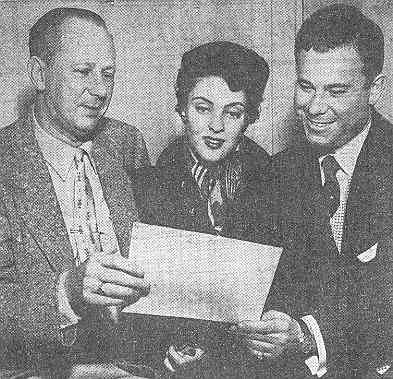 |
At the opening of the adventure
film "City Beneath the Sea", at the Palm Theatre in Detroit, February 1953:
from left, Lt. Harry E. Iieseberg, author of the story from which the movie
was made; Suzan Ball, starred in the picture, and Frank Westmore, of the
famous movie make-up dynasty.
From the Detroit Free Fress, 10 February 1953. Photos and press clipping courtesy of Marilyn Morgan. |
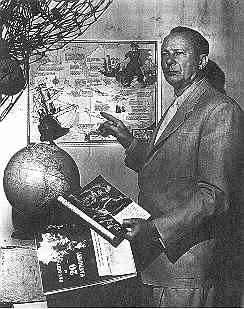 |
A Universal Pictures Co, promotional photograph of Lt. Harry E. Rieseberg. |
| ON THE PERSONAL SIDE
As reviously mentioned, Harry
had three wives.
Bob Rieseberg emailed the
following:
ARTICLE Seasports and the Shipping
World, March 1969.
|
| A FINAL WORD
Harry E. Rieseberg was an adventurer. That he achieved much in his life is not to be denied, and if his books are embellished with fantasy, then so be it. Nobody instructed Harry to be a maritime archaeologist or literary genius. He had fun, and he wrote about his adventures, some perhaps that resided soley in his mind, but above all, his stories were a great read. Of the number of youngsters that were, as a result of his many books and magazine articles, encourgaed to learn about the sea or indeed to take up diving, salavage and/or treasure hunting for pleasure or profit, we will never know. But whatever the statistics may be, Harry Rieseberg gave a great deal of pleasure to many people, young and old. |


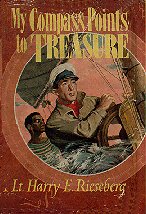
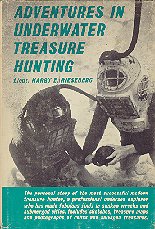
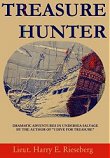
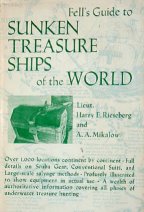

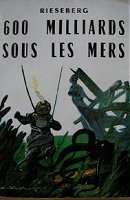
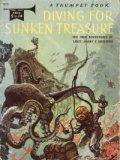
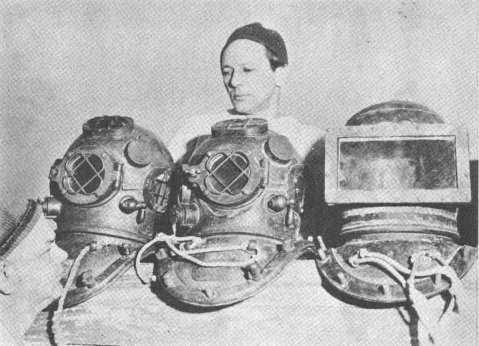
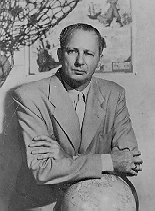
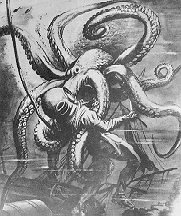
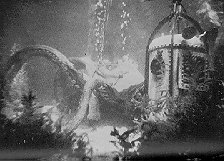
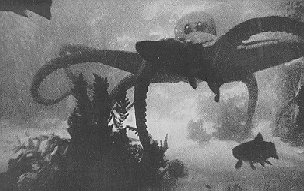
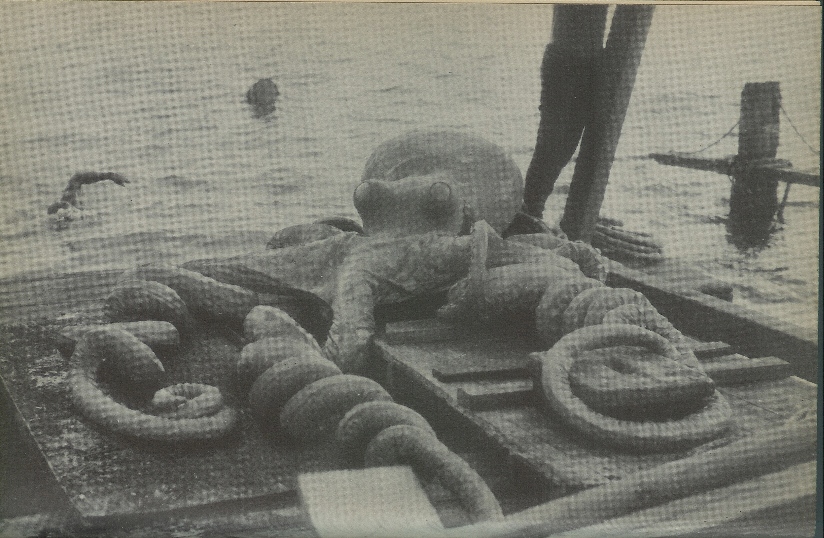
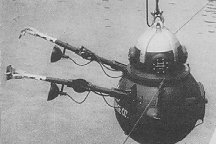 Rieseberg's
Robot.
Rieseberg's
Robot.
